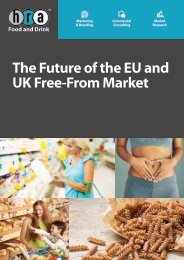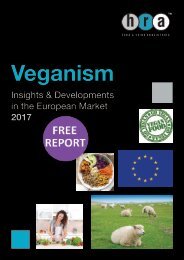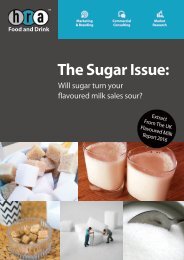Flavoured_Milk_Free
The backdrop to the UK flavoured milk market is one of relentless change. The removal of the EU milk quotas, the transition by emerging economies to a Western-style diet, the upcoming introduction of the ‘sugar tax’ and the booming sports nutrition industry are all aspects of change that create both challenges and opportunities for the UK flavoured milk market. HRA Food and Drink has developed this report as a map to guide industry stakeholders. Although volume growth in 2014 was slightly lower than in previous years, the flavoured milk market still has plenty of room for product innovation in the future.
The backdrop to the UK flavoured milk market is one of relentless change. The removal of the EU milk quotas, the transition by emerging economies to a Western-style diet, the upcoming introduction of the ‘sugar tax’ and the booming sports nutrition industry are all aspects of change that create both challenges and opportunities for the UK flavoured milk market.
HRA Food and Drink has developed this report as a map to guide industry stakeholders. Although volume growth in 2014 was slightly lower than in previous years, the flavoured milk market still has plenty of room for product innovation in the future.
Create successful ePaper yourself
Turn your PDF publications into a flip-book with our unique Google optimized e-Paper software.
UK FLAVOURED MILK MARKET 2017 & BEYOND<br />
For the UK flavoured milk market, this represents a key opportunity for export. This is<br />
especially true lactose-free milk products that fit with China’s high prevalence of lactose<br />
intolerance.<br />
8.12 Environmental concerns: tax on carbon emissions<br />
To view please<br />
purchase full report<br />
Figure 8.23: UK emissions from agriculture, forestry and fishing (ONS)<br />
According to the National Office of Statistics, total UK greenhouse gas (GHG) emissions<br />
have been decreasing year-on-year. However, emissions for the agricultural sector present<br />
a slightly more static pattern accounting for approximately 10% of the UK’s total GHG<br />
emissions (see figure 8.23). Cows are responsible for a large proportion of agriculture’s<br />
methane emissions through rumination, digestion and slurry management. It has been<br />
estimated that a typical dairy cow emits 117kg of methane annually, equivalent to driving<br />
12,000km in a petrol car (Houses of Parliament Postnote 2014).<br />
154<br />
© 2016 Teepee Limited. All Rights Reserved.







